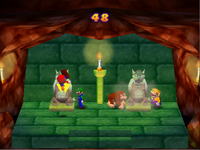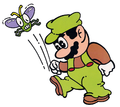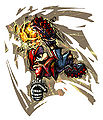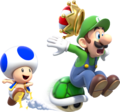Kick: Difference between revisions
mNo edit summary |
Nintendo101 (talk | contribs) m (→References) |
||
| (2 intermediate revisions by 2 users not shown) | |||
| Line 76: | Line 76: | ||
[[Category:Mario Party 7]] | [[Category:Mario Party 7]] | ||
[[Category:Mario Party 8]] | [[Category:Mario Party 8]] | ||
[[Category:Super Mario 64]] | [[Category:Super Mario 64 moves]] | ||
[[Category:Super Smash Bros.]] | [[Category:Super Smash Bros.]] | ||
[[Category:Super Smash Bros. Brawl]] | [[Category:Super Smash Bros. Brawl]] | ||
Latest revision as of 21:13, January 29, 2025
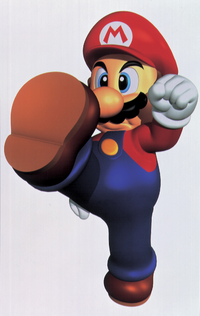
Kicking appears in the Super Mario franchise as a move closely related to punching, either as part of an attack combo or a midair attack. Almost every playable character with legs can kick, though Boo uses its tail instead. In some games, kicking is done by pressing the attack button while in midair.
History[edit]
Mario Bros.[edit]
In Mario Bros., Mario or Luigi must kick enemies after flipping them over in order to defeat them.
Super Mario series[edit]
Super Mario Bros.[edit]
Kicking in the Super Mario series was first seen in Super Mario Bros., where either Mario or Luigi was capable of kicking Koopa Shells at his opponents or obstacles. The kicking of Koopa Shells later returns in most future Super Mario games. The later games, such as Super Mario Bros. 3, also introduced the concept of kicking other objects aside from Koopa Shells in order to gain other effects.
Super Mario 64 / Super Mario 64 DS[edit]
Mario kicks to end an attack combo in Super Mario 64 and Super Mario 64 DS; he can also perform a kick in midair (called a Jump Kick),[1][2] to attack enemies and stall his fall (both Luigi and Wario are also capable of performing kicks in the latter game).
Super Mario Galaxy[edit]
In Super Mario Galaxy, Mario can kick enemies away after stunning them, like in Mario Bros. A move called the double kick also appears, and it gets its name because of how Mario does a kick with both legs while doing the move.
Super Mario Galaxy 2[edit]
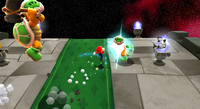
Mario can kick in Super Mario Galaxy 2, with the move having the same purpose as in its predecessor.
Mario Party series[edit]
Players can kick in various minigames in the Mario Party series. Doing so to other players usually stuns them temporarily, but kicking is sometimes used to destroy objects faster than punching. For example, in Destruction Duet in Mario Party 2, players can have their characters kick the Bowser Statues by pressing ![]() while in midair, damaging and eventually destroying the statues. In Rocky Road in Mario Party 6, Mario Party: The Top 100, and Mario Party Superstars, players can kick the boulders blocking their way to destroy them, but they must be careful not to kick and temporarily stun their teammates.
while in midair, damaging and eventually destroying the statues. In Rocky Road in Mario Party 6, Mario Party: The Top 100, and Mario Party Superstars, players can kick the boulders blocking their way to destroy them, but they must be careful not to kick and temporarily stun their teammates.
Mario Strikers series[edit]
Super Mario Strikers[edit]
In Super Mario Strikers, the game relies on this move a lot as the series is based on soccer, a kick-centric real world sport. The Super Strike, respectively, is the most powerful kick in the game.
Mario Strikers Charged[edit]
Kicking reappears in Mario Strikers Charged, having the same purpose as in its predecessor. In this game, the Super Strike was replaced by the Mega Strike, another powerful kick.
Super Smash Bros. series[edit]
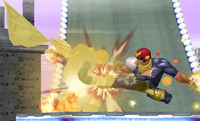
In the Super Smash Bros. series, almost all the playable characters are capable of using kicks as a form of attack. Midair kicks are also possible for some characters. Some kicks are also special moves, such as Captain Falcon's Falcon Kick and Ganondorf's Wizard's Foot.
Wario's Woods[edit]
In Wario's Woods, kicking is one of Toad's signature abilities in the game. He can kick aside the various enemies in the game to line them up with each other. With bombs, Toad can kick them if they are set on the ground.
Profiles[edit]
Super Mario Bros. 3[edit]
- Wii Virtual Console manual description: "After jumping on a Koopa, you can pick up the shell by running into it from the side while pressing
 . To kick the shell, let go of
. To kick the shell, let go of  ."
."
Gallery[edit]
Artwork[edit]
Luigi kicking a Fighterfly in Mario Bros.
Mario kicking a Shellcreeper in the Family Computer/NES version of Mario Bros.
Mario kicking a White Block at a Buster Beetle in Super Mario Bros. 3
Mario kicking a Green Shell in Super Mario World
Mario kicking a Green Shell in Super Mario Bros. Deluxe
Toad kicking a Green Shell at Luigi to get his crown in Super Mario 3D World
